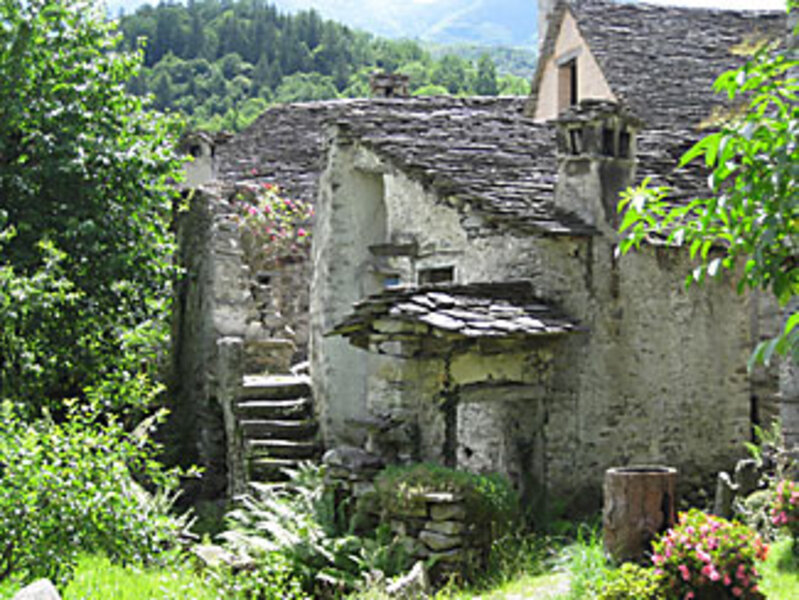In northern Italy, a medieval village restored to life
Loading...
| Canova, Italy
A thick heat permeated the crowded office of the notary in Domodossola, a small city in Italy's Piedmont region. Only 43 property-owners had arrived and tension in the room was rising. The last one, the group soon learned, was tending a herd of 30 cows high in the alpine pastures.
Closing the final chapter of a classic Italian bureaucratic drama, a helicopter was dispatched to ferry the missing owner into town. Still in his pasture clothes, he placed the 44th signature on the deed of a medieval stone house in the village of Canova. It now had a new owner committed to restoring the long-neglected domicile.
The process is a familiar one to preservationist Ken Marquardt, who worked for four years to gather those owners under the same roof. Italy's complex system of property inheritance had spread the home's ownership across centuries, multiple generations, and three continents.
This is just the most recent chapter in the restoration efforts of Mr. Marquandt and his wife, Kali, transplanted Americans who two decades ago acquired and restored a house here. In the intervening years, their work expanded to include other restorers and 10 more houses in the abandoned medieval village and spurred a modest revival. Canova now has a population of 15: six families and four part-time residents who share a common appreciation for stone architecture.
Canova's slide into ruin began after World War II when residents of the Ossola Valley slowly left the villages for factory work in the cities. Few people remained to trim the vines from the intricate stonework, and faithful villagers knocked down Canova's medieval arches to make way for the Madonna's head as they passed through the village during the procession of the Virgin Mary each May.
In 2001, the Marquardts and a group of local allies founded the Canova Association to raise awareness about the neglected state of medieval stone architecture in the region. The nonprofit group – whose members are mostly local restoration architects, teachers, builders, and residents – hosts field schools and exhibitions in the village and offers restoration consultations throughout the valley.
Though the organization's focus is on Italy, similar stone houses are found in a belt stretching from Ireland through the Alps to distant Turkey, where the Marquardts' field-school model has been adopted.
A walk through Canova offers a window on the rituals of everyday life and the spaces and tools that facilitated them for hundreds of years. Rooms are textured by stones worn smooth over centuries, deep built-in ovens, wash basins, and strong stone walls and roofs.
"We have a need of knowing these materials, of knowing how to live in these spaces, like we need bread," says architect Enrico Pinna. "Very few people have the capacity to imagine the architecture they really want, but this [work] will help us better understand what it is we need."
The association's work is guided by a dedication to the principle of reuse, a deep knowledge of materials, and an approach to restoration that looks at a structure's myriad incarnations over the course of history.
"Too often, restoration attempts to make buildings seem perfectly new, but then they lose some of their beauty," says Paolo Volorio, a Canova Assocation member and restoration architect who teaches at the Politecnico di Milano. "I prefer a method of restoration which understands that houses always changed over time and that there is no 'pure' original structure." The architect advises homeowners about how to stabilize medieval stonework and avoid demolition.
While laws in Italy facilitate the protection of national monuments such as castles, fortresses, and piazzas, restoration of private houses is left to individual communities. This means, Mr. Volorio explains, that local jurisdictions often indulge the interests of well-financed applicants who choose complete rebuilding over structurally sensitive restoration. The deeper problem, he thinks, is not with the Italian laws but with a predominant aesthetic of newness which tends to favor luxe, symmetrical villas over modest, and often idiosyncratic, homes. Changing that mentality through education, collaborations, and consultation, is part of the Canova Association's mission.
The association plans to expand restoration efforts to neighboring Ghesc, a medieval village that rests on a gently sloping hillside ringed with walled terraces. The village has been abandoned for more than 50 years and none of the houses have roofs except one – the home of a young couple who received a grant from the Piedmont region intended to help first-time buyers own a restored home of their own. This renaissance of restoration is bringing life back to villages one house at a time.





